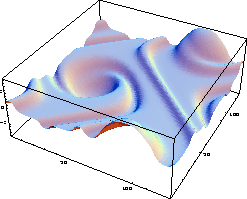We are concerned with the approximate solution of
the 2D Euler (- and respectively - NS) equations, expressed in terms of
the vorticity, ![]() ,
,
![]()
Here, ![]() , is the two-component divergence-free velocity field,
, is the two-component divergence-free velocity field,
![]()
Equation (1.5.48) can be viewed as a nonlinear (viscous)
conservation law,
![]()
with a global flux, ![]() .
At the same time, the incompressibility (1.5.49) enables us
to
rewrite (1.5.48) in the equivalent convective form
.
At the same time, the incompressibility (1.5.49) enables us
to
rewrite (1.5.48) in the equivalent convective form
![]()
Equation (1.5.51) guarantees that the vorticity, ![]() ,
propagates with
finite speed, at least for uniformly bounded velocity field,
,
propagates with
finite speed, at least for uniformly bounded velocity field,
![]() .
This duality between the conservative
and convective forms of the equations
plays an essential role in our discussion.
.
This duality between the conservative
and convective forms of the equations
plays an essential role in our discussion.
To approximate (1.5.48) by a second-order central scheme
(following [16, 31])
we introduce a piecewise-linear polynomial MUSCL approximate solution,
![]() , at the discrete time levels,
, at the discrete time levels, ![]() ,
,
![]()
with pieces supported in the cells,
![]() .
.
As before, we use the exact staggered averages at ![]() ,
followed by the midpoint rule to approximate the corresponding flux.
For example, the averaged flux,
,
followed by the midpoint rule to approximate the corresponding flux.
For example, the averaged flux, ![]() is approximated by
Analogous expressions hold for the remaining fluxes.
Note that finite speed of propagation (of
is approximated by
Analogous expressions hold for the remaining fluxes.
Note that finite speed of propagation (of ![]() - which is due to
the discrete incompressibility relation (1.5.56)
below), guarantees
that these values are 'secured' inside a region of local smoothness of
the flow.
The missing midvalues,
- which is due to
the discrete incompressibility relation (1.5.56)
below), guarantees
that these values are 'secured' inside a region of local smoothness of
the flow.
The missing midvalues, ![]() , are predicted
using a first-order Taylor
expansion (where
, are predicted
using a first-order Taylor
expansion (where ![]() and
and ![]() ,
are the usual fixed mesh-ratios),
,
are the usual fixed mesh-ratios),
![]()
Equipped with these midvalues, we are now able to use the
approximate fluxes
which yield a second-order corrector step
outlined in (1.5.58) below.
Finally, we have to recover the velocity field from the computed
values of vorticity. We end up with the following algorithm.
The specific recovery of the velocity field outlined
above, retains the dual convective-conservative form of
the vorticity variable, which in turn leads to
the maximum principle [25].
![]()
As in the compressible case - compare (1.4.43),
the main idea in [25]
is to rewrite ![]() as a
convex combination of the cell averages at
as a
convex combination of the cell averages at ![]() ,
,
![]() .
.
In figure 1.5.14 we show the central computation of a 'thin' shear-layer problem, [5]. For details, consult [25].
\

Figure 1.5.14: t = 8 , 128*128
The ``thin'' shear-layer problem, solved by the second-order
central scheme
(1.5.53),(1.5.58) with spectral
reconstruction of the velocity field.